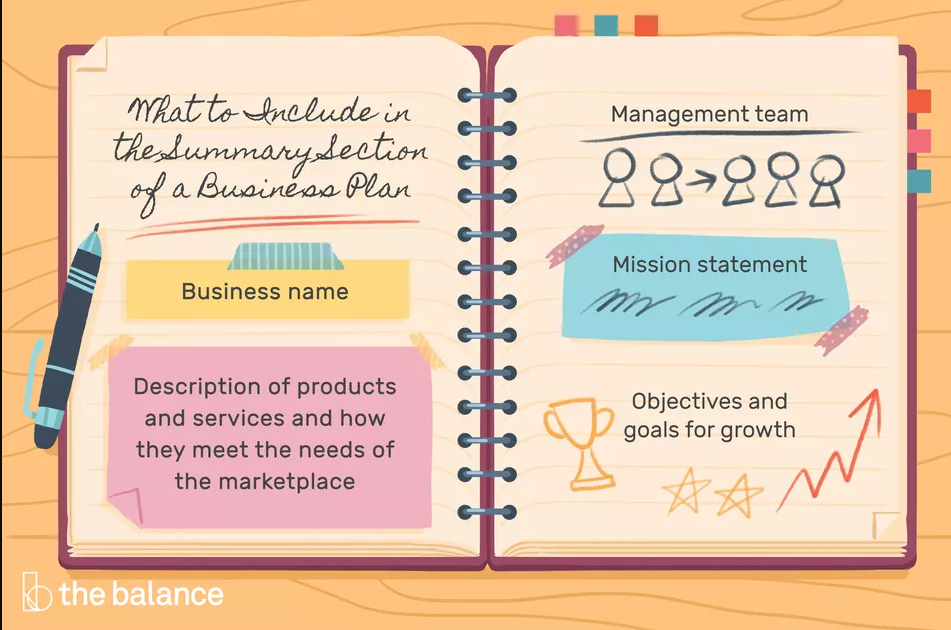Parts Of A Business Plan Template
Starting a business ideally begins with a written document called a business plan, and knowing the right components of a business plan templateis one step to produce that all-important document.
Not something to be overlooked, a business plan will prepare you, inform you, and give you direction – even boost your confidence – when you put up your business.
A business plan is so crucial entrepreneurs and startups research hard for it, financiers ask for it, and business writers profit a great deal from it.
If you know the integral parts of a business plan template, then that will be a good start for a future business owner like you.
Read further on below and learn.
First Part – Cover Page
This first page of a business plan template is also referred to as the “Title Page.”
The Cover Page or Title Page contains the following information:
- Company logo
You don’t have one? Well, better get one. A logo can give an added pull for your company.
- Company name
- Business tagline or business motto
Though optional, it’s still highly recommendable to have one. Again, for added pull; also, it can inspire you and your employees.
- The words “Business Plan”
Simply add them to clearly specify that the document is a business plan.
- Date
This is the date – just the month and year are acceptable – the business plan was finished written.
- Name of the contact person
State the full name of the person presenting the business plan. This person is the one to be contacted by whoever the business plan was presented to.
- Contact person’s job title or position
It will inform the one reviewing the business plan about the exact role the contact person takes up in the company.
- Contact information
Give (whenever applicable) the following (in this order):
- office address
- mailing address
- landline phone number
- fax number
- mobile number
- web address
- email address
- social media account(s) and corresponding social media handle(s)
- Copyright notice
Include one to inform whoever will read your business plan that the document is protected by copyright law.
Remember, your business plan should never be copied by anyone.
- Confidentiality statement
This can be stated in one or two sentences, informing whoever is reading the business plan not to disclose its contents to anyone.
Sample Cover Page
Based on the parts of a Cover Page as listed above, here is a sample outline of it:
Company Logo (placed on top of the page)
Superstar Films, Inc.
“Weaving stories on the silver screen since the ‘50s.”
BUSINESS PLAN
January 2021
David A. Davidson
Founder & President
Superstar Films, Inc.
1234 Santa Monica Boulevard,
West Hollywood, CA 90038
P.O. Box 56789
West Hollywood, CA 90038
Tel.: (323) 123-4567
Fax: +1 234 000 1234
Mobile: +1 789 246 4321
www.SuperstarFilms.com
info@superstarfilms.com
Facebook: Superstar Films USA
Instagram: @superstarfilms
Twitter: @superstar_films
YouTube: Superstar Films, Inc.
Copyright Notice
xxx
Confidentiality Statement
xxx
A piece of advice: regarding this first part of a business plan template, it’s up to you what designs, colors/color combinations, fonts, and font sizes to use. Still, be careful to pick only the appropriate ones. By appropriate, it means that your choice of design, color, and font should render your business plan an overall professional look.
Second Part – Table Of Contents
Create one to make it quick and easy for anyone who will read your business plan to find and go to a particular section.
Third Part – Executive Summary
The Executive Summary should have your:
- Company name
- legal name (your company’s registered name in a government agency)
- trade name (only if you have one)
- Company location
In general, the Executive Summary also includes information about your company’s:
- Objective and value proposition
- Target market or customer
- Describe your target market/client/customer.
- Cite an existing need or desire of your target market that your company meets or provides.
- Give proof or validation that your target market indeed has the existing need(s) or desire(s) you identified.
- Products and/or services
- Describe the product or service you’re offering.
- Specify if you’re selling a product, a service, or both.
- Explain how your product or service meets the need(s) or desire(s) of your target market.
- Sales and marketing strategies
- Competitive analysis
- Talk about your competitors.
- Tell how you compete with them in the market.
- Name the advantages you have over them.
- Management team
- Give an overview of the key people in your management team.
- State how each participates in meeting the company objectives.
- Indicate how many people you employ.
- Financial summary
- budget allocation
- Funding
- financial projections
- sales projection over the next three years
- income projection covering the next three years
8. Major significant achievements so far
- Outline your company milestones.
9. Future-oriented goals
- Enumerate your company’s future plans.
If your company happens to be around for quite some time already, then be sure to add in the Executive Summary:
- your company’s vision-mission statement or mission statement
- brief history of your company
- total number of present employees
- if applicable:
- location of headquarters
- number of stores/plants/factories and their respective locations
Fourth Part – Company Overview
This part of a business plan template can also be called “Industry Overview” or “Company Summary.”
Describe your company and don’t forget to include:
- Company name (both the registered/legal name and, if any, the trade name)
- Location
- Business structure
- Management team
- Mission statement
- Company history
- Product(s) and/or service(s)
- Target market
- Company’s competitive advantage
- Goals and objectives (short- and long-term ones) and growth plans
- Summary of start-up assets
- the things you will need to put up your business, such as:
- office equipment
- office furniture
- vehicles
12. Summary of start-up costs/expenses
- examples include government-related permits
- insurance coverage (fire, auto)
- rent and utilities
Fifth Part – Market Analysis
This section of a business plan template is also known as “Industry Analysis.”
The Market Analysis part should include:
- Industry Description and Outlook
- Target Market Research and Analysis
- Buyer Persona
- A Name
- Background
- personal
- professional
- Demographics
- age
- gender
- ethnicity (and so on)
- Goals
- “I need/I want” declaration/statement
- Pain points (your target customer’s problems)
- Buying behavior
- Environment
- physical
- social
- technological
- a quote of the most important thing for the buyer
- a photograph of the buyer
- Market Size
- total addressable market (TAM)
- total market size
- Market Testing (don’t confuse this with product testing)
- Market Test Results
- Based on the results, determine if people like your product/service. Now, if they do, are they willing to buy it/pay for it?
- Lead Time (how long it takes to fulfill an order)
Sixth Part – Customer Analysis
Making a customer analysis or customer profile – basically an analysis of your company’s customer base – involves the following three key steps (preceded by a question):
- Who are your potential and target customers? Identify them.
- What are the needs/wants/desires of your customers? Know and define them.
- What is the product/service your company sells/offers? Show and explain how your product/service meets the needs/wants/desires of your customers.
With that said, the Customer Analysis part of a business plan template should therefore include:
- Customer Identification
- Customer Demographics
- Customer Behavior Analysis or Behavioral Analysis
a. Customer Buying Criteria
- the factors why a customer buy a particular product or avail a specific service over the others
b. Purchase Process and Patterns
- includes the decision-making process involved when a customer buys a product or avails a service
- a customer’s past purchase/buying behavior
- Product or Service Analysis
Seventh Part – Competitive Analysis
The whole concept embracing this segment of a business plan template can be encapsulated in three words: “Know thy competitors.”
Competitive analysis principally involves knowing your competitors on a broader and deeper level. It entails understanding their objectives, recognizing their strong points and limitations, and identifying their marketing strategies, to name a few.
It's imperative for you to forecast how your competitors will react with your company’s presence in the market. What will they possibly do when you enter the market and get your hands on their market share? Sounds like war, agree?
To ensure you won’t be trampled down by your competitors, include the following information under Competitive Analysis:
- Competitors
- direct competitors
- indirect competitors
- strengths and weaknesses
- SWOT Analysis
- Barriers to entry
- The risks and problems that will confront your company once you enter a particular market.
- Window of opportunity
- Is your company going to make good use of an emerging market?
- Projections
- Market share
- Price structure
- discount offers
- gross margin
- Regulations
- to be specific, government regulations that could impact your company both positively (e.g., tax incentives) and negatively (e.g., restricting laws)
Eight Part – Marketing Plan
If you’re looking for financiers and investors, the potential ones will want – no, demand – to know your company’s marketing plan. Why? The marketing plan will tell how your company will perform in the market, move ahead of the competition, and, ultimately, earn money (for you and for them).
This particular part of a business plan template, a roadmap (marketing plan) within a roadmap (the whole business plan), contains the following subsections:
- Objectives
- Product/Service and Unique Selling Proposition
- Pricing and Positioning Strategy
- Sales and Distribution Plan
- Distribution Methods and Channel
- Sales Strategy
- Transaction Process
- Advertising and Promotion Plan
- Advertising
- Marketing Materials
- Publicity
- Sales Promotion/Promotions Strategy
Company Website
- Marketing Strategy
- Traditional Marketing Strategies
- Online Marketing Strategies
- Marketing Budget
- give the estimated cost per action
- Performance Analysis
- Expense Analysis
- Market Share Analysis
- Revenue Variance Analysis
- Financial Projections
Ninth Part – Operations Plan
Business location.
That’s one critical aspect you’ll be dealing with under this section of a business plan template. That and the day-to-day operations and the physical or tangible things that you’ll need to run your business, such as:
- office (if you happen to be a manufacturing company, then you’ll need a warehouse)
- equipment
- supplies
Note that an operations plan depends on the kind of business you have and how large it is. The operation plan, for example, of an international shipping company will include more components than that of a home-based travel agency.
Even so, the Operations Plan part should include these subsections:
- Development
- Supply Chain Management
- description of production workflow
- distribution and logistics plan
- order fulfillment process
- Production
- production time frame
- possible problems
- quality control checks
- Facilities
- physical location
- office/facility layout
- (if applicable) leasing cost and mortgage cost
- estimated overhead costs
- Staffing
- sourcing of employees
- employment relationship
- principal responsibilities of key workers
- training needs
- Equipment
- needed specialized equipment
- Are you going to buy or just lease?
- equipment costs
- Supplies
- Inventory Management
- main sources and suppliers
- needed materials
Tenth Part – Management Team
You have reached the part of the business plan template where you will describe the management and organization of your company.
This section may include all or some of the following people:
- Founder(s)/Owner(s)
- Executive Committee/Team
- President
- Chief Executive Officer (CEO)
- Chief Operating Officer (COO)
- Chief Financial Officer (CFO)
- Chief Marketing Officer (CMO)
- Chief Technology Officer (CTO)
- Shareholders
- Board of Directors
- Consultants/Special Advisors
- Department Heads
Outline the major roles and responsibilities of the key people in your company. You may present their qualifications and industry experience in the form of a brief résumé.
Eleventh Part – Financial Plan
A couple of tips when you start doing this part of a business plan template: one, be honest; two, be optimistic but at the same time realistic.
The Financial Plan section includes the following information:
- Balance Sheet
- Income Statements
- Cash Flow Projections
- Financial Projections
- for 12 months
- annual projections for the first five years
- Break-even Analysis
Final Part – Appendices And Exhibits
You have come to the last section of a business plan template.
All the pertinent pieces of information that support the claims and data you presented in the different sections of the business plan, put them here.
The Appendices part may include the following:
- Appraisal
- Articles of Incorporation
- Business permit
- Contracts
- Copies of insurance policies
- Financial projections
- Balance sheets
- Cash flow statements
- Income statements
- Licenses
- List of customers/clients
- Owner’s credit history
- Patents and trademarks
- Marketing/promotional materials such as brochures
- Detailed results of the market research you conducted
- Résumés of the founder/owner, executive team, and upper management team
- Supporting documents for any statistics, studies, trends you presented
Those are 12 integral sections or parts of a business plan template, each with several subsections.
So, the next time a business idea pops up in your head and you want to go for it, don’t just get excited and expectant.
Create first a business plan.
Make sure to include the parts of a business plan template enumerated here.
You want to earn high and succeed after all, right?




